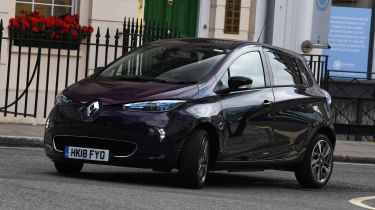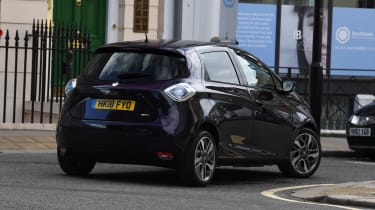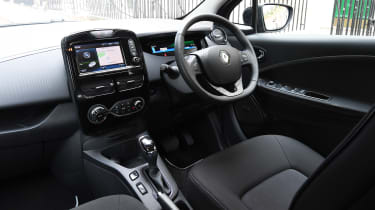New Renault ZOE R110 2018 review
The all-electric Renault ZOE has been updated for 2018, and with it comes a new more powerful 106bhp motor

The updates to the Renault ZOE bring a welcome dose of power, while keeping the old car’s usable range. Otherwise, it remains the same spacious, relaxing, all-electric supermini it was before. It’s worth sitting down to do some sums; the ZOE could save you money relative to established petrol or diesel-powered alternatives. Cars it’s more than good enough to be judged against.
There’s definitely more ostentatious electric cars than the Renault ZOE, but few are as successful. The ZOE has been the best-selling EV in Europe three years in a row, and only in 2018 did it slip behind the latest Nissan Leaf. It’s a car that is – quite literally – going quietly about its business.
To keep it fresh, the ZOE gains a range of updates for 2018. The infotainment system gets Android Auto for the first time and there’s a new purple paint finish on the options list. The range has been simplified, as well, with just two trim levels to choose from.
This Dynamique S Nav we’re testing here has all the kit you’d ever need; a seven-inch touchscreen with sat nav, auto headlights and wipers, climate control and rear parking sensors are all standard. The top spec Signature Nav adds leather seats, a Bose hi-fi (a £350 option on the Dynamique S Nav), and a rear parking camera.
The most significant upgrade comes to the motor, which produces 16bhp more than the old one. It’s an increase that is welcome on the move. While Renault quotes a 0-62mph time of 11.9 seconds (an improvement of 1.3 seconds over the old car) – at low speeds it feels much faster than those numbers suggest. The electric motor gives instant throttle response, letting the ZOE launch away from junctions and dart into gaps in traffic.
Used - available now

2021 Hyundai
Ioniq hybrid
9,291 milesAutomaticPetrol1.6L
Cash £16,287
2020 Vauxhall
Crossland X
3,569 milesAutomaticPetrol1.2L
Cash £13,087
2020 Peugeot
3008
26,607 milesManualDiesel1.5L
Cash £14,987
2020 Mercedes
C-Class Coupe
38,216 milesAutomaticPetrol2.0L
Cash £19,087Elsewhere, the ZOE is much the same as before. A near-silent drivetrain, light steering and smooth ride makes it easy and relaxing to drive around town, though the brakes can be a little grabby in stop-start traffic. The weight of the batteries can be felt through faster turns, too, which makes the front end wash wide more easily than in a petrol supermini.
Inside it looks smart enough, and the 338-litre boot is bigger than most small cars. Some of that space is inevitably taken up by the bulky charging cables, however.
The extra performance hasn’t harmed range, either, which at a claimed 186 miles (or 124 miles in cold weather) is the same as before. On a dry August day, the fully-charged ZOE’s trip computer predicted a decent 160-mile range – but our car wore optional 17-inch alloy wheels, which trim a few miles from the standard car’s potential.
After the government’s plug-in grant is taken into account, the ZOE starts from £18,420. However, for that price you don’t own the battery – instead you rent it for an additional £59 per month. If you’d like to buy the battery outright, it’ll cost you another £5,600.
That may sound like a lot, but should you take the ZOE on a 36-month PCP finance deal, it appears much more reasonable. Battery-owned cars cost another £1,000 or so up front, and £11 extra per month (£269 per month versus £199 per month plus £59 battery rental.) It does, however, come with a significantly higher optional final payment, which in effect means that it’ll hold its value much better than a battery-rented ZOE.
So the starting price of the ZOE is about the same as a highly-specced petrol supermini, but is it cheaper to run? Data from Pod Point suggests that if you charge your EV overnight on an off-peak tariff, you’ll pay around £3.64 to add 115 miles of range.
Compare this to a hypothetical petrol hatchback which averages 45mpg around town, and there’s a tipping point of just under 6,650 miles per year. If you exceed this mileage, have access to a charge point, and cover lots of short journeys, the ZOE will be cheaper to run than a petrol car. And that’s without taking into account its lower service bills.











